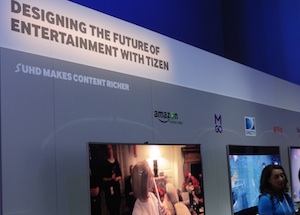
Or maybe just the future of washing machines.
The Tizen operating system is at the center of Samsung’s Internet of things strategy, according to a company blog post. Backed by Intel and others as well as Samsung and originally intended to be an alternative to Android in the mobile phone space, Tizen’s focus appears to have shifted to embedded systems…
Tizen requires less processing power and memory, thereby ensuring faster device speeds while consuming less energy…
Because it is lightweight, Tizen is optimal for use across a wide spectrum of smart connected devices in the IoT space. While devices with high demand for computing power, such as smartphones and TVs, are part of the IoT, so are devices that require relatively less computing power, such as wearables, vacuum cleaners and washing machines.
Samsung isn’t giving up on Tizen for heavier applications. It’s still the OS of choice for its smart TVs and it’s launched a Tizen-based smartphone in India, albeit to a lukewarm reception.
But clearly Samsung is looking at a development fork: a smart, processor-intensive version that might or might not find a useful place amongst the other descendants of Unix, versus a strategy of optimising it for the stripped down requirements of the moderately bright devices that are likely to comprise the vast majority of IoT nodes.
That’s in keeping with the promise that Samsung CEO BK Yoon made at CES last month, saying “our IoT components and devices will be open. The Internet of Things needs an open ecosystem”. Where Android is a creature of Google, the Tizen project runs under the flag of the Linux Foundation. Samsung and Intel are first among presumed equals in managing the project, but given the foundation’s governance structure that needn’t always be so.
One of the key reasons smart phones took off was the fact that purpose-built operating systems were developed. Whether or not it’s Tizen, an open source, community-managed device OS that’s optimised for lightweight IoT needs and directly integrated with the security, control and networking operating systems that’ll tie them together is the best way forward.
